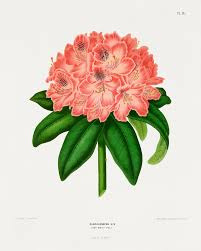'If eyes were made for seeing...'
This poem records a moment in May when the poet spots a rhododendron blossoming, heralding spring in all its glory and prompting some unforgettable musings on the nature and purpose of beauty
Ralph Waldo Emerson, ‘The Rhodora’ (1843)
In May, when sea-winds pierced our solitudes, I found the fresh Rhodora in the woods, Spreading its leafless blooms in a damp nook, To please the desert and the sluggish brook. The purple petals fallen in the pool Made the black water with their beauty gay; Here might the red-bird come his plumes to cool, And court the flower that cheapens his array. Rhodora! if the sages ask thee why This charm is wasted on the earth and sky, Tell them, dear, that, if eyes were made for seeing, Then beauty is its own excuse for Being; Why thou wert there, O rival of the rose! I never thought to ask; I never knew; But in my simple ignorance suppose The self-same power that brought me there, brought you.
What we love about this poem…
The full title of this poem is "The Rhodora: On Being Asked, Whence Is the Flower", and in its progress rejects the folly of asking what the ‘point’ of a flower’s beauty might be. Emerson’s later philosophical writings on nature, beauty, and the spirit (especially his book, Nature, (1836)) are incipient here, but there’s something more besides. The affectionate, intimate addresses between flower and bird, bloom and desert, wind and solitude, eye and sight draw us in to a sense of place that communicates in gestures and signs beyond language.
About the author
Ralph Waldo Emerson (1803-82) was an influential and innovative American writer well known for his non-fiction essays, nature writing, and poetry. You can read about his many contributions and achievements here.
To Read Alongside…
Elizabeth Barrett Browning in one of our previous newsletters is similarly arrested by an encounter with a palm tree: O my palm tree! And we—of course—must mention William (and Dorothy) Wordsworth’s iconic wanderings amongst unexpected flowers, Golden, dancing, jocund, laughing daffodils.
A search for more disquieting encounters with flowers might take you to Sylvia Plath’s ‘Tulips’ (1962) (‘too red in the first place’), or the purple hibiscus that flourish under the care of Aunty Ifoma but turn red in the violence and struggle of Papa’s garden in Chimamanda Adichie’s first novel, Purple Hibiscus (2003).
Reminder to please fill out our survey
We would love to hear about your reading habits and how LitHits has impacted you. In the past two years, we’ve heard comments and suggestions individually from so many of you, and this means a great deal to us. For the first time, we’re conducting a survey to improve our work and learn more about how you read through a 5-minute questionnaire.
Click this button to start the survey:
Thank you from the LitHits team!
Feedback
We'd love to hear your thoughts on our newsletter:
kshepherdb@yahoo.co.uk
Graphic design by Sara Azmy
All curation content © 2025 LitHits. All rights reserved.



